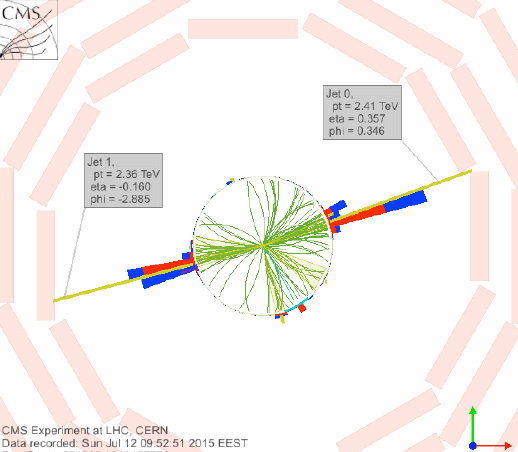For the time being, I can offer a couple of very inspiring pictures. CMS recorded a spectacular event featuring two extremely high-energy jets in the first 40 inverse picobarns of data that was collected and reconstructed by the experiment with all detector component properly working.
The two jets have a combined invariant mass of 5.0 TeV, which is an extremely rare occurrence even for a 13 TeV collision - in fact, just one such event was collected so far, out of several trillion collisions. Such a feature can be produced by a very heavy particle (like, say, 5 TeV) which decays into a quark-antiquark pair. If such a thing does exist, that is. Or less excitingly, by a very rare scattering of two quarks or gluons in the two colliding objects.
The picture below is a computer reconstruction of the event kinematics in the plane transverse to the beam direction. The coloured bars illustrate the energy recorded in the calorimeters, and the charged tracks are reconstructed as green curved trajectories.

A different, three-dimensional view can better give an idea of what the event looked like. Here the CMS detector is pictured as a cylinder - in fact, the detector has a cylindrical symmetry around the beam axis, although it is a quite complex device. These pictures, in fact, only summarize the high-level information about the reconstructed particles' energies and momenta.

The event was a spectacular one, but physics books are not written out of single, unrepeated occurrences. Not in the XXIth century anyway. We need to collect many such events before we can claim that a resonance has been produced - five or more, let's say: as statisticians tell you, statistics can only be worked out of five-or-more event sets. Below that, we are in the realm of the scientific curiosity, the unexplained, the weird, the rare, the irrelevant. So let us wait until the data collected by CMS will be in the several hundred picobarns range: then, a 5-TeV resonance might start making itself hard to ignore.




Comments